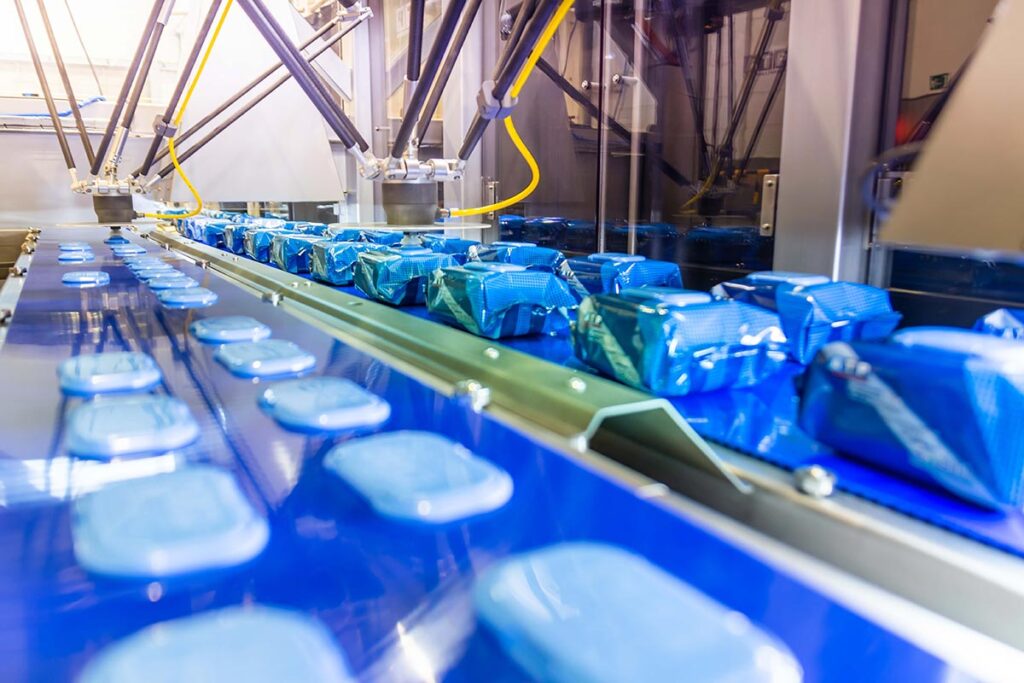
The automated packaging of wet wipes has revolutionized the way these essential products are manufactured, handled and distributed. Although it may not seem like it, we are talking about a product that was first used in the 1950s as a more practical alternative to cleaning babies with a cloth and water. It was a small revolution that made life easier for many families with babies.
Today, wet wipes are also used for adult personal hygiene, especially when traveling or away from home, and their chemical components and textures have even been adapted to develop wipes for intimate hygiene, household cleaning, and even wipes designed to clean industrial tools and equipment or device screens.
With the proliferation of wipes over the past few decades, wet wipes manufacturers have had to optimize production to make it faster and more efficient, and to adapt it to different packaging formats, such as small practical formats for everyday use, or industrial formats for professional cleaning.
In this article, we will take a closer look at the various components and technologies involved in the automated packaging of wet wipes.
What do we mean by wet wipes? Origin and peculiarities
As we have already mentioned, wet wipes were first used for the hygienic cleaning of babies (baby wipes), and soon after their use was extended to other hygiene and personal care applications: toilet paper, make-up remover, intimate care, moisturizers, suntan lotions, among others. Over time, they have been extended to other types of applications: household cleaning, automotive, etc.
As a common factor, the material used for the manufacture of wipes is called non-woven, although there are different types, qualities and liquid impregnation depending on the use of each type of wipe.

The specifics of wet wipes packaging
Stacks of wipes are made from rolls using machines called “converting machines”. Stacks of wipes can vary in size and number of units depending on the design.
Once the stack of wipes has been produced, it must be packaged in an airtight and barrier package (so that oxygen cannot enter and leak from the inside of the package). For this purpose, complex, multi-layer, thick films are used, which can vary depending on the type of product and speed. Packaging is done on hermetically sealed flowpack machines with long, high pressure, cross sealing heads.
Currently, flowpack machines with two pack infeed are also being used to reduce sealing speeds and use more economical films in terms of composition and thickness. The latest development in this field is the longitudinal and transversal ultrasonic sealing, which makes it possible to work with recyclable and thinner films while maintaining the barrier. The flowpack machine also punches the film and applies the opening sticker, which is used as a reference for applying the lid.
The lid is placed on the package to provide a reliable system for taking out the wipes one at a time, to ensure that when the lid is closed, a portion of the wipes remain within the inner thickness of the lid, and to minimize air infiltration to keep the wipes moist for a longer period of time. The lid replaces resealable stickers, which deteriorate faster, are more difficult to open and close, and require two hands to open the package, unlike lidded packages that can be opened with one hand.
Machines needed for wet wipes packaging
Having seen the process of the previous point, what do we need to package wet wipes?
- Flowpack machine
The flowpack machine wraps up the wet wipes in a film and hermetically seals the edges to ensure the freshness and hygiene of the product.
- Lid Feeders
Its function is to automatically feed the lids to the applicators that place the lids on the package.
- Double vertical magazine
This is the simplest of all the systems and is always integrated with the lid applicator, even if an automatic feeder is incorporated to provide occasional support. It is based on two metal magazines with the dimensions of the lid, with an opening for manual placement of the lids.
- Rotary Carousel
It is a manual loading system with several magazines installed in a rotating carousel; when a set of two magazines is emptied, it moves one step and two full ones enter the position of the pusher device that places the lids on the conveyor belt or pusher that feeds the applicator.
This system makes it easy to work with different types of lids thanks to a fast format changeover system.
- Robotic Bulk Feeder
The Robotic Bulk Feeder is the most advanced lid feeder on the market. This highly flexible robotic system is designed to adapt to different lid geometries and lid materials. Using vision technology, the robot picks up the lids and places them neatly on the conveyor that feeds the lid applicator.
- Lid Applicators
The lid applicator is a robotic cell that uses a vision system and Delta robots to automatically detect, apply glue, and position the lids on the wipes package.
- Multiformat Case Packer
The Multiformat Case Packer allows products to be placed in different positions in already formed cases. It can pack wipes packs vertically, horizontally, or edge-to-edge, providing great flexibility in terms of pack formats and product configurations in the cases.

The impact of sustainability on the wet wipes industry
As in virtually every industry, there is one trend that is influencing companies’ production: the adoption of more sustainable practices, processes and materials.
In this particular sector, recent regulations are requiring manufacturers to use more sustainable materials, such as biodegradable non-wovens and 100% recyclable plastics. Although there are already biodegradable non-woven products on the market, such as wet toilet paper, there is a need to extend this practice to other products, such as baby wipes. As for recyclable plastics, challenges related to leak-tightness are being addressed.
In the specific area of lids, the production of lids can be made from 100% recyclable plastic, a measure that contributes significantly to waste reduction. In addition, innovative alternatives are being explored using derivatives of raw materials such as rice, wheat and other agricultural crops.

What are the challenges of packaging automation for wet wipes?
In addition to implementing more sustainable practices, another challenge in wet wipes packaging automation is the application of lids, which can vary in material, shape, size, color, and other aspects. These lids can be divided into two main groups:
- Oval lids: These are generally the fastest to handle.
- Square lids: Their handling speed is slower compared to the oval ones.
The function of this device is to apply a thin thread of hot melt to the base of the lid, which then is placed over the area of the pack, where the wet wipes access sticker is located.
The specific challenge is the accuracy of applying the hot melt bead to the base of the lid, with very tight tolerances ranging from ±0.5 to ±1.5 mm. Lid application speeds vary from 80 to 150 lids per minute.
Quality Control with Vision, an Essential Factor in Wet Wipes Packaging
On the other hand, wet wipes packaging still has to overcome traditional challenges to avoid the most common problems. Fortunately, vision systems integrated into the lid applicator ensure optimal quality of wet wipes packages by detecting the most common defects and allowing for early correction:
- Pack with no lid.
- Pack with lid incorrectly positioned, either vertically or horizontally.
- Pack with misaligned lid.
- Pack with incorrectly oriented lid.
In summary, the automated packaging of wet wipes faces significant challenges today and in the future, particularly in the areas of sustainability, efficiency and customization. The integration of advanced technologies such as artificial intelligence and robotics into packaging machinery will be critical.




